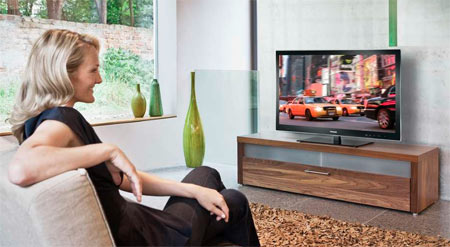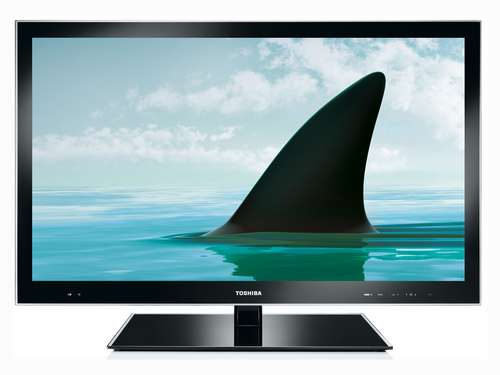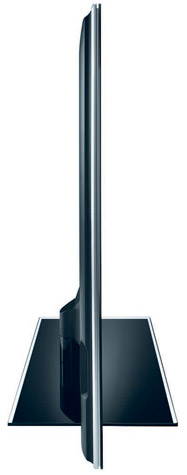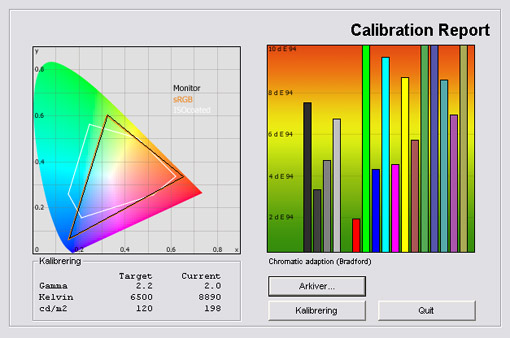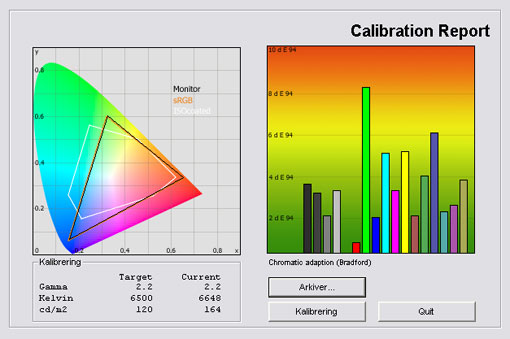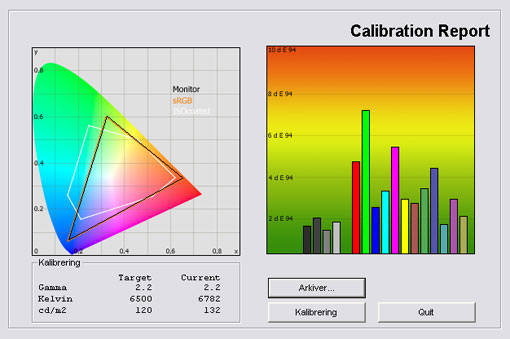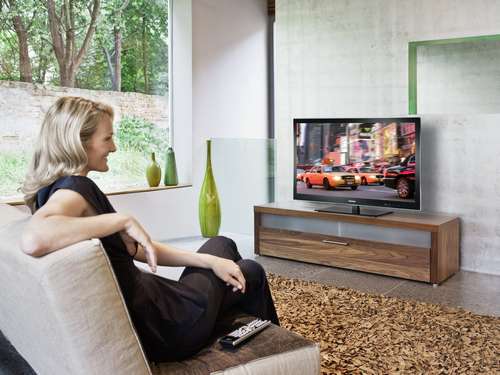Review: Toshiba VX700 / VL748
Toshiba VX700 / VL748 review
Toshiba has released a range of new TVs designed by Danish Jacob Jensen Design. One of them is the VX700 (in the US) / VL748 (in the EU) with a slim Borderless design, Internet access, and Toshibas own picture circuit. It’s a mid-end TV competing with models such as the Samsung C6000 and Panasonic G20.
But can Toshiba’s new TVs compare to popular models from Samsung, Sony and LG? And how good is the multimedia functionality? FlatpanelsHD will find out in this Toshiba VX700/VL748 review.
The TV is called VX700 is the US and will be available in 46 and 55 inches called 46VX700U and 55VX700U. In most EU countries the TV is called VL748. In the UK it’s called VL758 and will be available in 40 and 46 inches called 40VL758 and 46VL758. Please notice that the design is also a bit different on the US model.
Subscribe to our Newsletter to receive e-mails when new reviews are online. We’ll soon publish our Sony HX909, Samsung C9000, Fujitsu P27T-6 and BenQ BL2400PT reviews as well.
Size: 40" widescreen Resolution: 1920x1080 Response time: 6 ms (g2g) Contrast ratio: 5.000:1 Brightness: 430 cd/m2 Color support: 16,7 million colors Signal processing: 8 for each color Viewing angles (H/V): 178/178 Dot pitch: Panel type: LCD with Edge LED Wall mounting: Swivel stand: Dimensions (HxWxD): 65.5cm x 95c7 x 2.9cm (without stand) Weight 26 kg Built-in speakers: Input formats: 480p/i, 576p/i, 720p, 1080i & 1080p (50, 60 & 24p) Inputs VGA DVI (but possible to convert through HDMI)
Audio (type) (Audio in/out)
SCART (1 input)
S-video Composite Component HDMI (4 inputs, 1 HDMI 1.4)
Other Outputs Audio (type) (1 output, headphones)
SCART S/PDIF (optical)
Other Tuners Analogue DVB-T DVB-T (MPEG4) DVB-C DVB-C (MPEG4) DVB-S DVB-S (MPEG4) Other Price and retailer:
| US retailer | UK retailer |
 |  |
Our first impressions
Toshiba has collaborated with Jacob Jensen Design and this partnership has given rise to a slim and elegant design with a Borderless front. The bezel behind the one-sheet-of-glass design is made form a high gloss black material.The stand has been made from glass and is very robust. It also has a swivel function. The stand looks a bit different on the US VX700 model.
The connection jacks are located on the back of the TV and Toshiba has – cleverly – decided that all inputs point either downwards or to the side, paving the way for smooth and easy wall mounting.
In the lower right corner a few touch sensitive buttons have been integrate
Except for the Power LED all LEDs are invisible until you touch the frame with your finger - easy and elegant.
Test tools
Our TV signal is DVB-S (satellite) from Canal Digital and DVB-T (terrestrial). We also have an analogue TV connection. Testing is done with the DVE (digital video essentials) and Peter Finzel test DVD. Testing is also done with DVD, TV, Blu-Ray and Media center/PC.We use our own monitorTest. The software supports some of the traditional test patterns used to evaluate displays as well as some new and unique test patterns developed by the people here on FlatpanelsHD.
Sony PlayStation 3 is our Blu-Ray player.
All contrast measurements are based on the ANSI methodology.
Functionality
Below you see the remote control. It has large, square buttons and has been made from plastic.The remote control feels cheap and too lightweight. I had hoped for a more exclusive remote control that was in line with the TV design.
Toshiba also has an Ethernet jack and the TV is Wi-Fi Ready, which means that you can connect a Wi-Fi USB dongle for wireless network access. You can also use one of the two USB inputs for USB memory sticks. DivX is supported.
Toshiba has incorporated a YouTube-feature and a simple web browser that only has access to YouTube. Actually this means that you can use either the YouTube plugin or the original YouTube page on Toshiba’s TV.
The quality depends largely on the YouTube clip that you are watching. You can either see the most recent YouTube clips, the most popular or browse via the search function.
One strange thing I noticed was that the YouTube button disappeared when choosing some countries. If I selected UK it was there but with a Nordic setting it disappeared – strange…
Lastly, Toshiba has an integrated DLNA function. For supported formats see Toshiba’s site www.toshiba.com or www.toshiba.co.uk
Calibration settings
In the menus Toshiba VX700 / VL748 has the following picture presets: Backlight, Contrast, Brightness, Color, Tint, and Sharpness.
You can choose from these picture presets: Standard, Dynamic, Hollywood 1, Hollywood 2, Game, PC, and AutoView.
In the advanced menus you can adjust: Color (hue, saturation and brightness), Color Temperature, Auto Brightness Sensor settings, Active Backlight Control, Black/White level, Static Gamma, Noise Reduction, Active Vision M100, Film Stabilization, Resolution+, RGB (red, green, blue), and RGB IRE.
Energy consumption
Below I have measured energy consumption on the 40-inch version. |  | |
| Standby | 0.2 W | 0.2 W |
| SD+HD | 98 W | 88 W |
After calibration I measured energy consumption to 88 W, which is not fantastic compared to other Edge LED models but considerably lower than plasma-TVs and LCD-TVs without LED. For comparison Samsung’s C6000 TV consumes 72.2 W after calibration.
Also, please note that the flat panel TVs uses less power after calibration. This is common on flat panel displays because many picture parameters are reduced during calibration.
Calibration on Toshiba VX700 / VL748
Below you can see an out-of-box measurement on VX700/VL748 in the Standard picture settings without the Eco mode enabled.The graph says this:
The number on the left is the delta value. Delta is a difference between two factors; here it’s the difference between the measured color on the panel and the actual color that is our target.
Out-of-box picture accuracy is not very good. As you can see in the graph above the color deviations are too significant. Gamma is rising from 1.62 in the bright colors to 2.5 in the dark colors which means that dark shades are too dark (details are crushed) and bright shades are too bright (oversaturated colors).
The color temperature was measured to 8890 Kelvin which is typical for most LCD/LCD TVs today but too high compared to our 6500 Kelvin reference.
The brightness level was measured to 198 cd/m2 which is fair for daytime viewing but too high for viewing in dark rooms.
I changed to the Hollywood 2 picture preset and took a new measurement.
The Hollywood 2 preset is much better and color accuracy is greatly improved compared to the Standard picture preset. The Hollywood 2 preset is not perfect, however.
Gamma is still not stable at 2.2 (our reference value) but rising from 1.9 to 2.45. The color temperature is close to our 6500 Kelvin target with 6648 Kelvin.
I moved on to my calibration. You can see my result below.
I managed to improve gamma a lot and got very close to our 2.2 target. Gamma is now rising from 2.2 to 2.31 which is fair compared to most mid-end TVs today.
I also improved color accuracy and the color temperature is fairly close to the 6500 Kelvin target value. All in all a pretty accurate picture after calibration.
Below are my calibrated settings.
 | |
| Picture preset: | Hollywood 2 |
| Backlight | 49 |
| Contrast | 90 |
| Brightness: | 0 |
| Sharpness: | 0 |
| Color: | 0 |
| Tint: | 0 |
| Color Temperature | 2 |
| Active Backlight Control | Off |
| Black/White Level | 0 |
| Static Gamma | -10 |
| Noise Reduction | Off |
| White Balance – Setting type | 2P |
| Red-Offset | 1 |
| Green-Offset | 0 |
| Blue-Offset | -1 |
| Red-Gain | 5 |
| Green-Gain | -5 |
| Blue-Gain | -4 |
I lowered backlight because we typically optimize picture settings for viewing in dark rooms. If you primarily use your TV in a bright living room you might want to increase the settings called Backlight or activate the Eco sensor.
I also lowered the settings called Black/White level. This setting is the cause for the wrong gamma, so you need to lower it to 0. Lastly, I did a RGB (red, green, blue) calibration with the regular settings.
I did not take advantage of the more advanced RGB IRE settings but if you want to try to improve things further it is possible with Toshiba’s TV.
Picture quality on Toshiba VX700 / VL748
In this section I go through picture quality with the calibrated settings.Toshiba VX700 / VL748 has a glass front and therefore a lot of reflections. See the picture below from a standard room with celling lights.
Windows can also cause reflections in the glass front and a good tip is to increase the backlight setting option in the TV menu as it can reduce the most distracting reflections from windows - but in a brightly lit living room Toshiba’s glass front design is not the obvious choice.
In the previous section I examined color accuracy but color gradation is equally important. Color gradation is a term used to describe how well a TV distinguished the many different colors. To examine color gradation we use smooth color gradients and we hope to see a perfectly smooth gradient without"bands”.
And that was pretty much what we experienced. The color gradation on the Toshiba TV is great and considerably better than on most mid-end Edge LED based TVs today. I would even rate VL748 / VX700 considerably higher than the Samsung C6000 that we tested last year and on par with a TV such as Sharp LE820 in terms of color gradation, but lower than the Panasonic G20 plasma TV.
The great color reproduction is created with an internal color system in the Toshiba TV. Internal LUT (look-up tables) are required to ensure proper color gradation and many manufacturers economize on these systems to lower costs – but not Toshiba.
SD picture quality looked fairly good but I was never really impressed. Detailing is average and comparable to TVs such as Samsung Samsung C6000 and Sony EX500, although these TVs are a bit cheaper.
HD picture quality looked great and detailing was high. The good color gradation contributed to better HD detailing and I also felt that black was deep enough to create vivid and intense pictures on the Toshiba TV.
Motion resolution on the other hand could have been better. It’s not bad but when watching HD you might notice that detailing is reduced in fast paced action scenes or in games. I examined response time and trailing in our stress tests and I did see evidence of visible trailing. It’s not critical or anything but VX700 / VL748 is not on par with the plasma-TVs and the best scanning backlight based LCD-TVs in terms of response time today.
Toshiba’s frame interpolations system (100/120 Hz system) on the other hand is fair. It’s not too aggressive, causing images to look artificial and it only creates minor artefact noise. For Blu-ray viewing you should deactivate it but for most casual viewing it can smooth out moving images and reduce trailing.
I did not see overdrive trailing (halos around moving objects) – great.
Input lag was measured to 35-40 ms without the 100/120 Hz system. This is average and on par with most Samsung TVs.
Below I have measured black level and contrast.
 |  | |
| Black level | 0.07 cd/m2 | 0.05 cd/m2 |
| Brightness | 198 cd/m2 | 132 cd/m2 |
| Contrast ratio | 2829:1 | 2560:1 |
Contrast ratio +/- 100
After calibration I measured a black level of 0.05 cd/m2 which is pretty low for an Edge LED based TV and comparable to Samsung’s"LED-TVs” and some mid-end plasma-TVs. I was pleasantly surprised to see such low numbers from Toshiba, because most of their older TVs - such as the Toshiba ZV635 / ZV650 - had terrible black levels.
Shadow detailing is equally important and again Toshiba convinced me. I was able to distinguish almost every dark grey tone after calibration. Before calibration Toshiba VX700 / VL748 crushed most details in the darker movie scenes and games.
Below I have examined the Toshiba TV in a completely dark room to see if it has clouding or backlight bleeding.
Unfortunately we did see some light clouding at the corners of the panel. It’s was not really distracting in practice but I noticed it a few times.
PC and Media Center
The TV supports 1:1 pixel mapping. In order to achieve 1:1 pixel mapping you need to select the aspect ratio called"Dot by Dot” in the OSD.Viewing angles
The viewing angles are slightly above average. Most colors change form wide angles and contrast is also reduced, although a bit less than most LCD-TVs today.Below I have taken pictures of the viewing angles.
Contrast is reduced a bit from angles but I have seen far worse cases of bad contrast viewing angles.
Sound quality
The thin profile obviously sets limitations when it comes to speakers and the sound is not very impressive in the Toshiba TV.Bass is lacking but voices are clear. I would rank the speakers higher than Samsung’s speakers in their slim Edge LED based TVs but lower than the speakers in the Sharp LE820 and Philips 8605H.
For movies, music and games I recommend separate speakers.
Conclusion
Toshiba’s partnership with Jacob Jensen Design has given birth to an elegant TV with a glass front and a very slim frame. All inputs are facing either downwards or to the side. Toshiba has integrated YouTube access, DLNA and USB functionality but I feel that Toshiba lacks media functionality that compares to manufacturers such as Samsung, Sony and LG.Picture quality on Toshiba VX700 (in the US) / VL748 (in the EU) was surprisingly good for an Edge LED based TV. It’s not on par with high-end models but for a mid-end TV, I’m pretty satisfied. The out of box settings were not convincing but the"Hollywood” picture presets provided accurate and beautiful picture quality with a range of advanced picture settings. The color gradation was great and the black level is on par with the best Edge LED based TV – and some plasma TVs – today.
On the negative list we have the glass front that reflects light from surroundings and windows. Response time could have been better and we also saw some minor clouding – which was pretty much expected due to the fact that it’s an Edge LED based TV.
All in all Toshiba VX700 / VL748 feels like a complete TV and after the release of inferior products such as the ZV650/ZV635 I feel that Toshiba is definitely back in the game with their new TVs. This TV is a serious contestant to the Sony EX500 and Samsung C6000, and besides the obvious lack of proper multimedia functionality I feel that Toshiba VX700 / VL748 is better in terms of picture quality compared to especially the latter.
Price and retailer:
| US retailer | UK retailer |
 |  |
 |  |  |
| HD picture quality | Out of box picture settings | Living room |
| Black level for an Edge LED TV | Response time | Home Cinema |
| Inputs facing down or to the side | Reflections | |
| Color reproduction and gradation | Multimedia functionality lacking |

